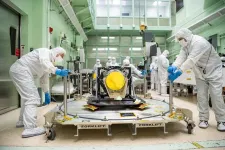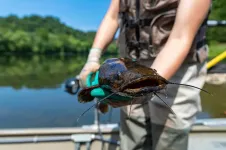(Press-News.org) Note to Editors: Video clips available at: https://duke.box.com/s/wtq3ofu3kf84ayw3qr6jajxdizt0rwxc
DURHAM, N.C. – Imagine sitting in a dark movie theater wondering just how much soda is left in your oversized cup. Rather than prying off the cap and looking, you pick up and shake the cup a bit to hear how much ice is inside rattling around, giving you a decent indication of if you’ll need to get a free refill.
Setting the drink back down, you wonder absent-mindedly if the armrest is made of real wood. After giving it a few taps and hearing a hollow echo however, you decide it must be made from plastic.
This ability to interpret the world through acoustic vibrations emanating from an object is something we do without thinking. And it’s an ability that researchers are on the cusp of bringing to robots to augment their rapidly growing set of sensing abilities.
Set to be published at the Conference on Robot Learning (CoRL 2024) being held Nov. 6–9 in Munich, Germany, new research from Duke University details a system dubbed SonicSense that allows robots to interact with their surroundings in ways previously limited to humans.
“Robots today mostly rely on vision to interpret the world,” explained Jiaxun Liu, lead author of the paper and a first-year Ph.D. student in the laboratory of Boyuan Chen, professor of mechanical engineering and materials science at Duke. “We wanted to create a solution that could work with complex and diverse objects found on a daily basis, giving robots a much richer ability to 'feel' and understand the world.”
SonicSense features a robotic hand with four fingers, each equipped with a contact microphone embedded in the fingertip. These sensors detect and record vibrations generated when the robot taps, grasps or shakes an object. And because the microphones are in contact with the object, it allows the robot to tune out ambient noises.
Based on the interactions and detected signals, SonicSense extracts frequency features and uses its previous knowledge, paired with recent advancements in AI, to figure out what material the object is made out of and its 3D shape. If it’s an object the system has never seen before, it might take 20 different interactions for the system to come to a conclusion. But if it’s an object already in its database, it can correctly identify it in as little as four.
“SonicSense gives robots a new way to hear and feel, much like humans, which can transform how current robots perceive and interact with objects,” said Chen, who also has appointments and students from electrical and computer engineering and computer science. “While vision is essential, sound adds layers of information that can reveal things the eye might miss.”
In the paper and demonstrations, Chen and his laboratory showcase a number of capabilities enabled by SonicSense. By turning or shaking a box filled with dice, it can count the number held within as well as their shape. By doing the same with a bottle of water, it can tell how much liquid is contained inside. And by tapping around the outside of an object, much like how humans explore objects in the dark, it can build a 3D reconstruction of the object’s shape and determine what material it’s made from.
While SonicSense is not the first attempt to use this approach, it goes further and performs better than previous work by using four fingers instead of one, touch-based microphones that tune out ambient noise and advanced AI techniques. This setup allows the system to identify objects composed of more than one material with complex geometries, transparent or reflective surfaces, and materials that are challenging for vision-based systems.
“While most datasets are collected in controlled lab settings or with human intervention, we needed our robot to interact with objects independently in an open lab environment,” said Liu. “It’s difficult to replicate that level of complexity in simulations. This gap between controlled and real-world data is critical, and SonicSense bridges that by enabling robots to interact directly with the diverse, messy realities of the physical world.”
These abilities make SonicSense a robust foundation for training robots to perceive objects in dynamic, unstructured environments. So does its cost; using the same contact microphones that musicians use to record sound from guitars, 3D printing and other commercially available components keeps the construction costs to just over $200.
Moving forward, the group is working to enhance the system’s ability to interact with multiple objects. By integrating object-tracking algorithms, robots will be able to handle dynamic, cluttered environments -- bringing them closer to human-like adaptability in real-world tasks.
Another key development lies in the design of the robot hand itself. “This is only the beginning. In the future, we envision SonicSense being used in more advanced robotic hands with dexterous manipulation skills, allowing robots to perform tasks that require a nuanced sense of touch,” Chen said. “We’re excited to explore how this technology can be further developed to integrate multiple sensory modalities, such as pressure and temperature, for even more complex interactions.”
This work was supported by the Army Research laboratory STRONG program (W911NF2320182, W911NF2220113) and DARPA’s FoundSci program (HR00112490372) and TIAMAT (HR00112490419).
CITATION: “SonicSense: Object Perception from In-Hand Acoustic Vibration,” Jiaxun Liu, Boyuan Chen. Conference on Robot Learning, 2024. ArXiv version available at: 2406.17932v2 and on the General Robotics Laboratory website.
###
END
Listening skills bring human-like touch to robots
Researchers give robots a sense of touch by “listening” to vibrations, allowing them to identify materials, understand shapes and recognize objects just like human hands
2024-10-22
ELSE PRESS RELEASES FROM THIS DATE:
Acclaimed WVU doctor and researcher elected to National Academy of Medicine
2024-10-22
A world-renowned West Virginia University physician and researcher has received one of the highest honors in the fields of health and medicine.
Dr. Sally Hodder, director of the West Virginia Clinical and Translational Science Institute, associate vice president for clinical and translational science at WVU and Chancellor’s Preeminent Scholar Chair, was elected to the National Academy of Medicine for her accomplishments as an infectious diseases physician and researcher.
Hodder, the first person from WVU to be chosen for the National Academy of Medicine, is one of only 100 new members from around the world announced at the Oct. 21 NAM ...
New study reveals larger insects' critical role in decomposition in arid ecosystems
2024-10-22
New study reveals that in arid ecosystems, larger arthropods such as termites and beetles play a crucial role in decomposition, challenging the traditional view that microbial activity dominates this process in dry environments. By demonstrating that macro-decomposition can peak during the summer in arid sites and that overall decomposition rates in these regions can be similar to or even exceed those in wetter climates, the research provides new insights into how decomposition functions in drylands and its implications for global carbon ...
NASA reveals prototype telescope for gravitational wave observatory
2024-10-22
NASA has revealed the first look at a full-scale prototype for six telescopes that will enable, in the next decade, the space-based detection of gravitational waves — ripples in space-time caused by merging black holes and other cosmic sources.
The LISA (Laser Interferometer Space Antenna) mission is led by ESA (European Space Agency) in partnership with NASA to detect gravitational waves by using lasers to measure precise distances — down to picometers, or trillionths of a meter — between a trio of spacecraft distributed in a vast configuration larger than the Sun. Each side of the triangular array ...
A new kind of authoritarianism: Democracy in decline at home and abroad
2024-10-22
A majority of Americans worry this year’s general election will be tainted by fraud, according to a recent NPR/PBS News/Marist poll released earlier this month—an ominous indication of the state of democracy in the U.S.
“When citizens lose trust in the electoral process, they may question the legitimacy of elected officials and the institutions they represent, which undermines the foundational principle that government authority is derived from the will of the people,” ...
Performance in physical tests can help manage treatment for metastatic lung cancer
2024-10-22
A study of patients with metastatic lung cancer by researchers based in Brazil and the United States has found that their performance in simple physical tests such as sitting down, standing and walking can help physicians arrive at a prognosis and approach to treatment.
An article on the study is published in the European Journal of Clinical Investigation.
The findings also included identification in the volunteers’ blood plasma of two substances – serine and M22G – with the potential to become biomarkers capable of indicating which patients are most likely to respond to chemotherapy.
The study was supported by FAPESP (projects 16/20187-6 and 19/17009-7), ...
Expanding access to weight-loss drugs could save thousands of lives a year
2024-10-22
New Haven, Conn. — Expanding access to new, highly effective weight-loss medications could prevent more than 40,000 deaths a year in the United States, according to a new study led by researchers at Yale School of Public Health and the University of Florida.
The findings highlight the critical need to remove existing barriers that are hindering people’s access to effective weight loss treatments and impeding public health efforts to address the national obesity crisis, the researchers said. According to the U.S. Centers for Disease Control and Prevention, about 74% of Americans are considered overweight, with about 43% of those individuals ...
Harnessing science to tackle global crises
2024-10-22
In a paper published in PLOS Sustainability and Transformation, an international team of researchers looked at how science could play a more active role in managing crises. The paper builds on the outcomes of the international conference “What Role for Science in Crisis Times? Outlook in the Health, Environment, and Agriculture Interconnected Areas”, held in Montpellier in 2022.
To enhance science’s contribution to crisis management, the paper emphasises the need for interdisciplinarity, where science is integrated across disciplines, and transdisciplinarity, which incorporates various societal actors and stakeholders. By co-designing and co-producing ...
Caltech's new fingerprint mass spectrometry method paves the way to solving the proteome
2024-10-22
Caltech scientists have developed a method driven by machine learning that allows them to accurately measure the mass of individual particles and molecules using complex nanoscale devices. The new technique opens the possibility of using a variety of devices for the measurement of mass and, therefore, the identification of proteins, and could pave the way to determining the sequence of the complete proteome, the collection of all the proteins in an organism.
Proteins are the engines of living systems. Which proteins are made, ...
Invasive flathead catfish impacting Susquehanna’s food chain, researchers find
2024-10-22
UNIVERSITY PARK, Pa. — Flathead catfish — native to the Mississippi River basin — were first detected in the Susquehanna River in Pennsylvania in 2002, according to the U.S. Geological Survey. In the two decades since then, the invasive species has spread throughout the river basin. The impact of the large predator on the waterway’s food webs and ecology was unknown, but now a research team is beginning to understand what Susquehanna flatheads are eating and how their presence is affecting native aquatic species in the river.
The findings, which the team said state ...
Javadi receives DOE Early Career Award to study qubit hosts
2024-10-22
NORMAN, OKLA. – Alisa Javadi, Ph.D., professor at the University of Oklahoma School of Electrical and Computer Engineering and the Homer L. Dodge Department of Physics and Astronomy, has received funding from the U.S. Department of Energy Early Career Research Program for research that offers the potential for advancing quantum technology development.
Javadi’s research will test the use of cerium oxide as a host for quantum bits, or qubits. Qubits, the building blocks of quantum computing, need an environment free ...
LAST 30 PRESS RELEASES:
Longest observation of an active solar region
Why nail-biting, procrastination and other self-sabotaging behaviors are rooted in survival instincts
Regional variations in mechanical properties of porcine leptomeninges
Artificial empathy in therapy and healthcare: advancements in interpersonal interaction technologies
Why some brains switch gears more efficiently than others
UVA’s Jundong Li wins ICDM’S 2025 Tao Li Award for data mining, machine learning
UVA’s low-power, high-performance computer power player Mircea Stan earns National Academy of Inventors fellowship
Not playing by the rules: USU researcher explores filamentous algae dynamics in rivers
Do our body clocks influence our risk of dementia?
Anthropologists offer new evidence of bipedalism in long-debated fossil discovery
Safer receipt paper from wood
Dosage-sensitive genes suggest no whole-genome duplications in ancestral angiosperm
First ancient human herpesvirus genomes document their deep history with humans
Why Some Bacteria Survive Antibiotics and How to Stop Them - New study reveals that bacteria can survive antibiotic treatment through two fundamentally different “shutdown modes”
UCLA study links scar healing to dangerous placenta condition
CHANGE-seq-BE finds off-target changes in the genome from base editors
The Journal of Nuclear Medicine Ahead-of-Print Tip Sheet: January 2, 2026
Delayed or absent first dose of measles, mumps, and rubella vaccination
Trends in US preterm birth rates by household income and race and ethnicity
Study identifies potential biomarker linked to progression and brain inflammation in multiple sclerosis
Many mothers in Norway do not show up for postnatal check-ups
Researchers want to find out why quick clay is so unstable
Superradiant spins show teamwork at the quantum scale
Cleveland Clinic Research links tumor bacteria to immunotherapy resistance in head and neck cancer
First Editorial of 2026: Resisting AI slop
Joint ground- and space-based observations reveal Saturn-mass rogue planet
Inheritable genetic variant offers protection against blood cancer risk and progression
Pigs settled Pacific islands alongside early human voyagers
A Coral reef’s daily pulse reshapes microbes in surrounding waters
EAST Tokamak experiments exceed plasma density limit, offering new approach to fusion ignition
[Press-News.org] Listening skills bring human-like touch to robotsResearchers give robots a sense of touch by “listening” to vibrations, allowing them to identify materials, understand shapes and recognize objects just like human hands





